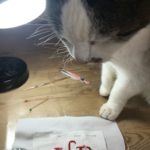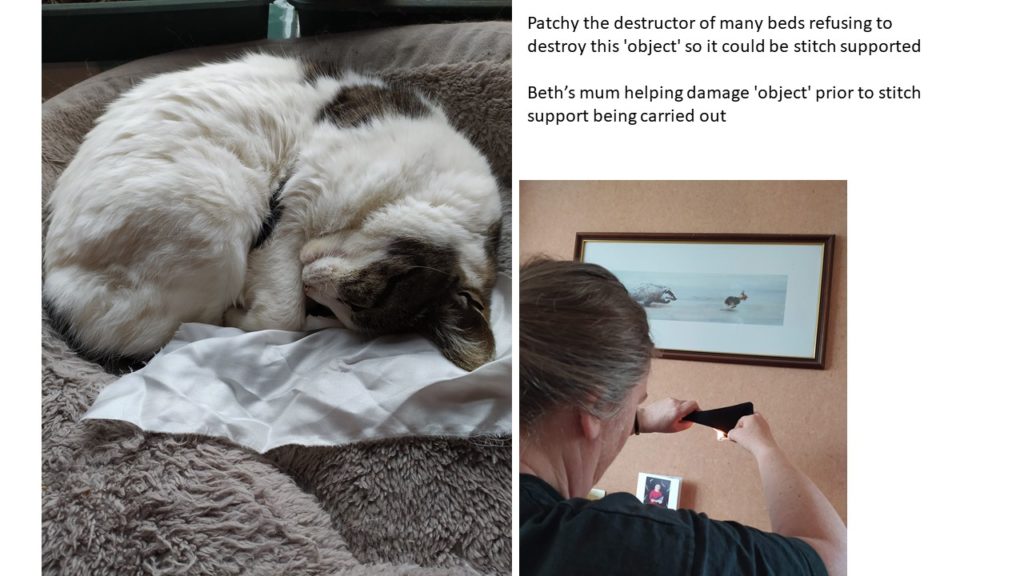
By Beth Gillions and Anna F Robinson
Setting the scene
March 2020: lockdown of the UK in response to the COVID-19 global pandemic has been declared and we, two first year textile conservation students, make a journey to the northwest of England to weather the uncertainty of lockdown with Beth’s family. The decision to leave our flat in Glasgow was made partly to alleviate the worries of both our parents (Beth’s in England and Anna’s in Canada) regarding potential isolation and restricted access to resources, and partly because we thought we might end up driving each other crazy if the pandemic were to last for months.
Beth’s family home is a modest two-story semi-detached house which is filled to the brim with all manner of craft supplies, tools, books, costumes and weaponry all related to the family’s passion for historical re-enactment. Adding in two conservation students to the existing three human and three (later five) animal household made it a rather full house: cozy eclecticism with just a hint of chaos!
Stitching exercises- A failed attempt at interspecies collaboration
Whilst the world around us changed we quickly had to create new methods and approaches which allowed the pursuit of our studies from afar. For the CTC the transition to online learning was inherently challenging, how do you promote practical skills in a hands-on discipline from a distance? The answer was provided when, not long after our arrival in Lancashire, a parcel of supplies from the lab landed on the doorstep with the instructions to use what we had available to develop our stitching skills. Our challenge was to consider how we could use standard conservation materials along with the household’s stash of odd fabrics, and the excess of household members to create uniquely challenging ‘objects’ for our stitching exercises.
To recreate natural patterns of deterioration on our ‘objects’, we looked for creative ways to inflict damage. Whilst the human household members were happy to oblige us by burning, ripping, or shooting arrows through fabric as directed, the animals were less enamoured by the concept of interspecies research collaboration. The dog looked offended, insisting that she is an innocent hound not inclined to destruction, the chicken was uninterested, and the cat was relieved we had finally seen fit to provide her with silk for her bed. Human intervention ensured that all objects were suitably damaged where animal test subjects had failed to do so.

Prior to stitch supporting the damaged objects some scavenging was required. Garden rocks wrapped in cling film acted as glass weights, baking paper replaced tracing paper, cut flush folders substituted Melinex®, and the kitchen table, along with every available light source were co-opted in an attempt to mimic lab conditions.

As with any experiment the challenges encountered were not those anticipated, and the rhythm of life in a household of five adults encouraged us to adapt and grow in unexpected ways. The need to clear the table each evening to eat, along with the cat’s insistence on laying across in-progress object treatments left unattended, created a series of small deadlines whereby the next stage of conservation had to be completed so the object could be safely moved. Unlike lab situations where objects can be left undisturbed as long as necessary, this challenged us to make the most effective use of any treatment time and encouraged reflection on how to provide best practice treatment in less than ideal situations.

Virtual placement research projects – scrounging supplies
The need to creatively source materials was not limited to our stitching exercises. Both of our independent research projects involved developing supports for museum objects we could not physically access; facilitating the creation of models to test our designs. Sourcing appropriate materials for both supports and model objects became the next hurdle. Scrounging from the household supplies we turned up cutting mats, loose batting and unidentified textiles. A call to Sarah in Glasgow for more conventional mount making supplies resulted in the arrival of a package of scrap cotton, twill tape, Fosshape® and a brick of Ethafoam® to work with; combined with online orders of wheat starch paste, glue guns, cardstock and cocktail umbrellas we developed an eclectic but useful range of materials to work with.
Returning to our new reality
Our stay ended several weeks after the loosening of lockdown measures, with the conclusion of our placement projects, leaving us both more confident in our abilities to communicate across unforeseen barriers, and adapt both spaces and our conservation practices to all kinds of unexpected situations. Overall, the work both of us did during lockdown, as well as that of our classmates, demonstrates the flexibility, versatility, and dedication of emerging conservators. While this chapter of our adventure may have ended, new adventures await us in our second year at the CTC and for that we can’t wait!


Your work was creative and enthusiastic despite the challenges. I liked Patchy!
wonderful inventiveness and commitment – thank you!
best wishes
Mary Brooks
wonderful work . Good luck .my greeting to all Textile conservation centre stuff and specially to Dinah Eastop and Mary Brooks, the greatest professor in textile conservation